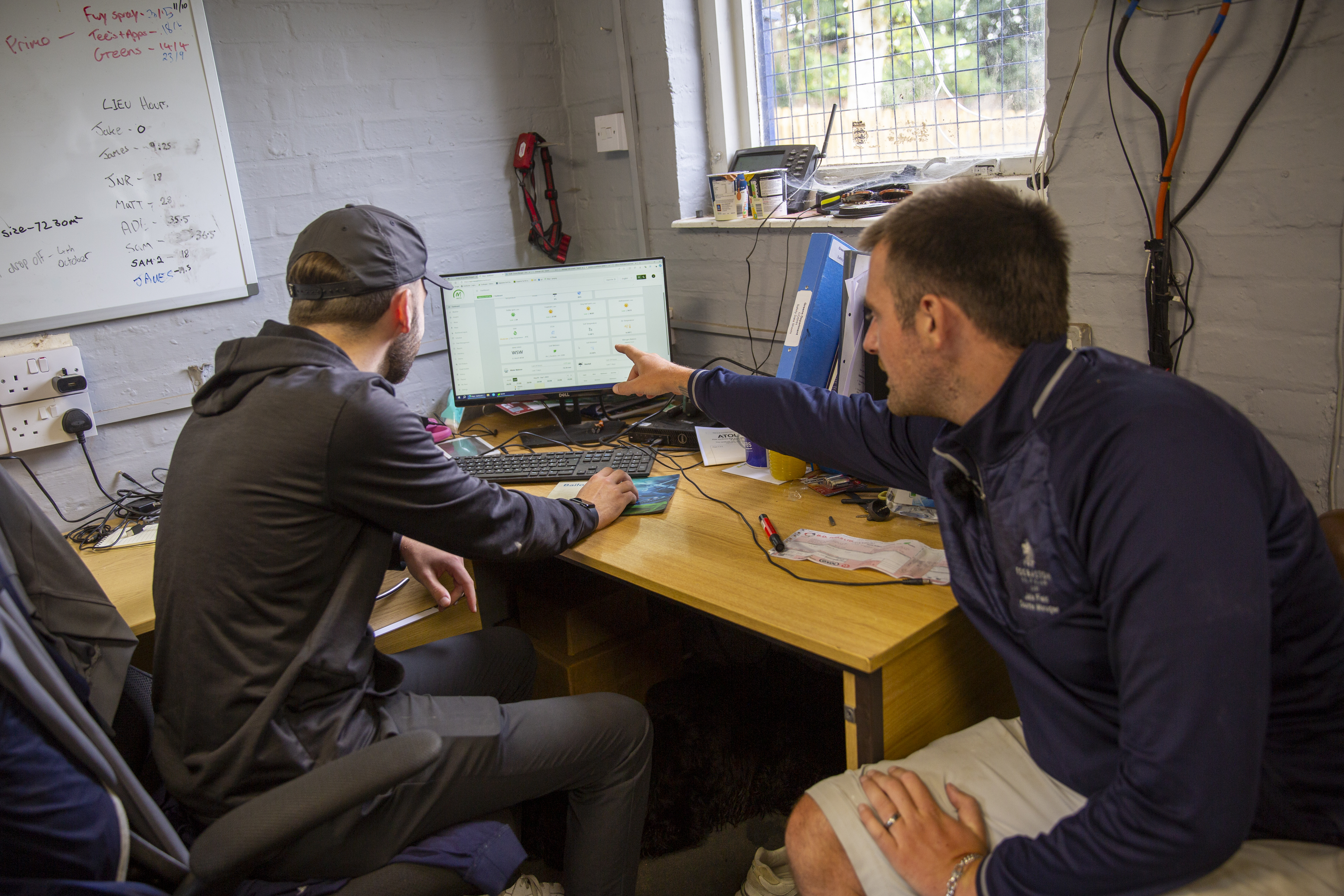I Spent The Day As A Greenkeeper To Learn The Tricks Of The Trade... It's Time They Got Even More Recognition!
Dan Parker spent the day at Edgbaston Golf Club to get an insight into the life of a greenkeeper and have a go at some of the key daily tasks


Greenkeeping is one of, if not the, most important profession in the golf industry. Heck, I wouldn’t have a sport to write about every day if greenkeepers weren’t busy maintaining golf courses. What would a golf course be without its team of greenkeepers? Up at the crack of dawn and often out of the way before golfers even have a chance to see them preparing the course, it’s a profession that often goes without much regard or praise day to day.
WATCH: Dan Parker joins Head Greenkeeper Jake Field for a day working at Edgbaston Golf Club
Working alongside BIGGA - the British and International Golf Greenkeepers Association - I was allowed to spend the day as a greenkeeper at Edgbaston Golf Club in Birmingham. I’d be shadowed by its Course Manager Jake Field throughout the day, who would tell me a little bit about how each task works as well as give me a go on all the important machinery and technology that helps maintain the golf course all year round. With my alarm set nice and early, I set off to central Birmingham to start my day.
5:30 am - Arrival & team meeting

I arrived at Edgbaston about 45 minutes before sunrise on a late summer’s day in August. Barely a mile away from Broad Street and on the other side of the road from Edgbaston Cricket Ground, Edgbaston is a parkland golf course and a welcome green burst of energy in the middle of the country’s second-largest city.
No one looks forward to early starts. Anyone who’s met me even a handful of times will know I look forward to these even less than the average person, but with a clear day of weather ahead I was excited to get stuck in to help prepare the course for the day ahead. Each of the eight-man greenkeeping team had their jobs already set out before they arrived and rolled out onto the course with headlights blaring. While they set out their business, Jake and I headed to the 9th green to start some early preparation.
6:15 am - Ironing the greens

My first job of the day would be on the green iron. The greens weren’t due to be cut on the day I was working, but on non-cutting days each green is still ironed in the morning.
‘The green iron is incredibly useful to help mitigate any turf stress at this time of year. During competitions or particularly busy periods for the course, we’ll typically cut and roll to help promote a bit of added speed and a nice roll too. The green iron itself comes into its own really during the winter months. When we don’t need to cut as much this is what we’ll use to still keep the greens rolling well as well as lifting any dew off the surface first thing in the morning.’
Subscribe to the Golf Monthly newsletter to stay up to date with all the latest tour news, equipment news, reviews, head-to-heads and buyer’s guides from our team of experienced experts.
As for operating the machine itself, I’m quite proud to say I picked it up pretty quickly. It moves side to side with rollers acting as the machine’s wheels. It can move pretty swiftly too. While I had it barely above walking pace to make sure I didn’t make any fatal errors, watching the greens staff work after my attempt was impressive and thorough. After the green had been rolled and prepared, it was time to take a reading.
6:45 am - Speed, firmness and moisture testing on greens

Once the green was prepped, it was time to take a variety of different readings to inform the membership of how they’ll be playing for the day as well as to allow Jake to take some key data on the condition of the greens. Our first test was testing green speed using a stimpmeter. This is one of the most important readings the team will take in the mornings, as it feeds important information to golfers for the day ahead and allows Jake and his team to keep a close eye on green speeds.
Using the stimpmeter, I found a flat piece of the green and rolled three balls down it. From there, you take the middle ball of the three, and that’s your measurement. Repeat the process in the other direction, measure, take an average and you have your green speed reading for the day.

I also completed a green firmness test. The Clegg Hammer measure green firmness in gravities by dropping a probe from about two feet off the ground onto the putting surface. Once a handful of measurements have been taken around the whole green, you’ve got your number. Edgbaston likes to have its firmness rating anywhere between 100 and 110 in the summer, and my average reading of the 9th green saw it come out at 110 exactly.
Finally, I completed a moisture test. Using a moisture probe allows Jake and his team to get specific measurements of small segments of greens to check for moisture. ‘Gone are the days when we had a lot of disposable water. Golf clubs are trying to be more sustainable and not overwater the golf course, so using this probe allows me to understand exactly how much moisture is in a section of green. Instead of having to set the sprinkler system on for a whole area that might not need watering, I can now hand hose the specific part of the green that needs some added moisture.’
7:30 am - Cutting the hole

With the green now ironed and all the relevant data checked, it was time for one of the most satisfying parts of the job - cutting the hole. ‘We always stay six feet away from the edge of a green as a starting point. Day to day, we try to go for six pin positions at the back, six in the middle and six at the front to keep things relatively easy for the regular, non-competition days. On most greens, we’ve probably got about 15-20 places we can conceivably put a hole and they can’t be sitting on a hill or anything too ridiculous.’
The equipment consisted of a cutting board - which stops the hole crowning when lifting the plug out and prevents footprints around the freshly cut hole - and a hole plug. It takes a bit of effort, but after hammering the plug into the hole of the cutting board, it made its way down and flush with the surface. A few twists of the plug and a hefty lift revealed a freshly carved-out golf hole. That plug of grass is placed back into the spot of the old hole and rolled to make it flush with the putting surface.
On the newly cut hole, I used a pair of scissors to cut away any fine pieces of grass that were overhanging the hole and then used a depth setter to make sure the hole is set at a precise depth of one inch. Edgbaston likes to paint the inside of its holes white as an added touch. I was only in charge of the 9th hole during my work, and I left the experts to quickly and efficiently mop up all 17 other hole changes on the day.
8:30 am - Mowing

One of the most labour-intensive parts of the day in the life of a greenkeeper was next up. Being a job that requires serious precision and training with the equipment, I was only allowed to mow one of the approach areas of the golf course, but it did give me a great opportunity to get a feel for how precise the greenkeepers are when mowing any part of the golf course.
‘Our teeing surfaces and approach areas are both cut at 8mm and are mown three times a week, fairways are cut at 13mm also cut three times a week, semi-rough is 22mm cut twice a week, rough is two and a half inches and greens and 3.5 mm.’
I found the mower quite an intimidating piece of equipment. Such was the precision of the member of staff who was mowing the approach before I arrived, it felt like there was a lot of pressure to maintain the straight lines and perfect cutting angles of the beautifully maintained course. Once I’d got to grips with how to accelerate and when to lower the mower blades, I found it a very therapeutic part of the process. I was relieved to see the straight lines and correct lengths of the approach area as I got off the mower and moved on to something a little less daunting.
9:15 am - Bunker preparation

‘Looking after bunkers is a huge labour cost for us,’ Jake told me as we headed to join one of the fellow greenkeepers preparing the greenside bunkers on the 4th green. ‘During heavy rain events especially, it’ll take a three or four-person team to get out onto the course and fix the washouts. We’ve recently installed a new rubber crumb liner under all of our bunkers which prevents sand contamination, and weeds growing through the sand and prevents washouts. From a playability point of view, it’s great for the golfers and it saves us a lot of labour hours in bunkers.’
Bunker preparation was one of the more self-explanatory but time-consuming parts of the day. Each bunker is raked from the middle up and out to leave it in perfect order. Jake did have some words of advice for golfers on how to rake a bunker after use and where to leave the rake. ‘We tend to see a pulling motion as golfers rake their way out of a bunker. What I want to be seeing is more of a pushing motion back into the centre of the bunker so the sand doesn’t build up around the edges and leave piles in the back of the bunker and not enough sand in the middle. As for where to put the rake when you’re done, this is an opinion thing, but I like to see the whole rake in the bunker.’
No amount of technological advances can replace the precision and time it takes for an individual to prepare a bunker properly. After making sure the greenside bunker on the 4th was looking perfect for the members, I was glad to hand this particular job back to the rest of the team. The rubber crumb system used at Edgbaston appears to already be worth it’s weight in gold for Jake and his team. The lack of washout in particular means the team don’t have to spend hours and hours repairing bunkers after a heavy downpour.
10:30 am - Green aeration

This task isn’t something that happens every day in the life of a greenkeeper, but it is arguably the most important maintenance job that happens throughout the year. Luckily, Jake gave me some insight into why the job takes place, and what it does for the greens and allowed me to have a go on the club’s practice green.
‘We typically heavily aerate the green during August. What this process does is allow the plant to take up nutrients from the soil, get gas and air into the roots and break up some compaction in the soil that comes from the mowing and ironing. When the soil is so compact, it means the grassroots are unable to spread, so without aeration, the plant would struggle to survive. Simply put, regular aeration gives us a better, healthier grass plant. The reason we do it in August is because we want the recovery process to be as quick as possible. Communication is important, so we let the members know it's coming and help them understand why we do it at this specific time.’
The machine I used to aerate the practice chipping green produced smaller tynes that the team uses on the greens every 6 weeks. Twice a year, the team at Edgbaston will use a machine that produces larger holes to give the greens a more thorough aeration to decompact the soil. As Jake explained, it is such a vitally important task to help maintain green health throughout the year.
11:30 am - Forecasting and disease prevention

Here’s where my journey as a greenkeeper took a turn for the technological. Edgbaston has recently invested in a new AI forecasting system called Maya, which Jake has heralded as the future of greenkeeping. The system utilises sensors positioned underneath the surface of every green to monitor conditions and feed that data back to a hub in Jake’s office.
‘This technology feeds me data on soil temperature, moisture and salinity which allows it to create a pretty comprehensive disease forecasting system. If I see a small outbreak of disease on a green, I can send a Whatsapp message to Maya to let it know and then it builds a database of information on what the conditions were like in the soil to allow that disease to arrive. Once it understands that, it can then predict when conditions will be in a position for a potential disease outbreak. If the weather and ground conditions are all lining up, Maya will send me a notification to let me know and then we can put a plan in place to prevent that outbreak from occurring. It’s allowed us to be preventative rather than curative, which is a much better way to maintain a golf course.’
Back in Jake’s office, the Maya dashboard allows him to see live ground conditions across the golf course, incredibly accurate weather data and a dashboard of insights into potential disease activity across all 18 greens. Anthracnose is a common fungal disease that can often befall golf courses, and Maya offers Jake a clear chart showing the likelihood of an outbreak. On the day I was there, the chart showed the last four days of potential anthracnose activity, one of the days showing a value of over 40 - a red flag for Jake. This had allowed him to go and treat the green ahead of time and prevent an outbreak on the green in question. Using AI, the chart also predicts the likelihood of disease breakout for the following two days.
12:30 pm - Home time

With course prep all completed well before noon, Jake’s team continued with some of the smaller tasks of course maintenance before their days finished. Jake and I grabbed a coffee at the clubhouse to reflect on the day’s work, and I had the opportunity to ask Jake more broadly about the profession and why he enjoys it so much.
‘It’s a fantastic career. Even though the weather can be bad at times, you’ve got the beauty of being outside all day and pleasant days like this make it all worthwhile. There’s a huge misconception that all greenstaff do is mow grass and that’s just not true. The way technology is moving forward, there’s so much more to greenkeeping than what the members see us doing out on course.’
I thoroughly enjoyed my day as a greenkeeper. With the late summer sunshine dappling the course all morning, it’s hard to imagine a better ‘office’ space to work from. Jake’s role is far greater than just mowing and maintaining. The new technology is allowing him to forecast more successfully, use his labour more efficiently and in turn use resources more efficiently. With an emphasis on golf courses becoming more sustainable in their uses of water, pesticides and other chemicals this technology appears to be the tipping point for an even more tech-heavy future for those in the greenkeeping profession.
If you're interested in finding out more or becoming a greenkeeper, visit the BIGGA website.

Dan has been with the Golf Monthly team since 2021. He graduated with a Master's degree in International Journalism from the University of Sussex and looks after equipment reviews and buying guides, specializing in golf shoes, golf bags, golf trolleys, and apparel reviews. Dan is also a co-host of Kick Point: The Golf Gear Show. A left-handed golfer, his handicap index is currently 7.1, and he plays at Fulford Heath Golf Club in the West Midlands.
Dan's current What's In The Bag:
Driver: Cobra DS-Adapt X
Mini driver: TaylorMade R7 Quad Mini
Fairway: Ping G440 Max 21°
Irons: Titleist T250 (5), Titleist T100 (6-PW)
Wedges: Ping Glide Forged Pro (50, 56, 60)
Putter: TaylorMade Spider Tour X
Ball: Titleist Pro V1x
Grip: Golf Pride Tour Velvet
Bag: Vessel Sunday III